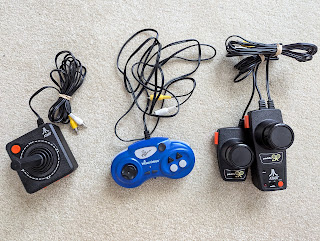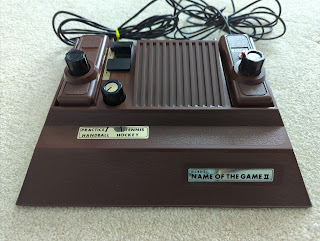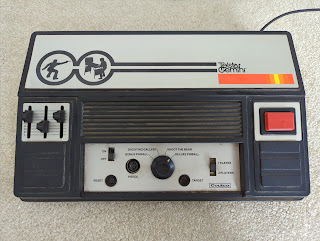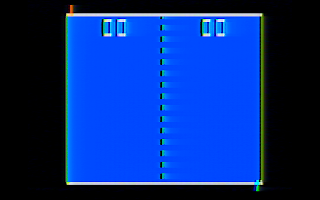Saturday, June 29, 2024
Two tiny 65816 DTV consoles
Sunday, October 1, 2023
Finally, an MOS 7600/7601 Video Game Array data sheet
The 7600 is now fairly well understood thanks to Sean Riddle's die photo, which Ken Shirriff exhaustively explored, but no one had ever found a data sheet — until earlier this summer. This data sheet is dated "Preliminary April 1976/Revision 1 June 1976," consistent with the earliest 7600 I've seen from 42nd week 1976, and gives the 7600 an official name, the Video Game Array (an unfortunate acronym collision). It specifically covers the original 7600-001 variant, an NTSC TV-compatible part that plays Pong in tennis, hockey and handball/squash/racquetball variations as well as a target practice mode, and is the variation present in most Pong consoles that used the MOS VGA. The mask ROM is explicitly stated as 512 words in size, which is read and executed by the "frame processor," acting as a combination I/O chip and CPU. The FP reads the opcodes from ROM, acquires player input, maintains the score, and sets up the display and audio output for the chip's analogue output stages.
The part that's gratifying is that the pinout and circuitry Ken and Sean independently figured out is nicely confirmed by the documentation, including the external colour support circuitry generated independently for player 1's paddle ("bat"); player 2's; and the ball, background, walls and score numbers. For even lower-cost systems, it supports a rainbow sweep system that just generates a rainbow colour pattern instead and is generated internally on-chip, though I have yet to find one of these systems myself. Interestingly, this mode requires a 3.595314MHz crystal instead of the usual NTSC colourburst frequency 3.579545MHz oscillator, which is one "line frequency" greater than the standard subcarrier (and that may be why I haven't encountered one yet, since ~3.58MHz crystals are substantially more common). It doesn't appear that the 7600 supported any other clock rates.
This data sheet confirms virtually all of our informed conjecture and fills in a few more gaps, but it appears to be missing at least two pages (between figures 4.1B and 4.6), does not have a complete pinout (only block diagrams), and since it comes from the beginning of the line naturally completely lacks a production history. We also don't know if there were pinout differences between the -001 and the later -002 through -004 variants, though this particular data sheet warns that "[f]uture games of the VGA series (MPS 7600-XXX) may make use of an expanded switch matrix ... Designers may wish to take account of this fact when producing printed circuit board layouts incorporating the VGA." The best understanding presently remains that there were only ever four game versions and Commodore, MOS' new owners that same year, discontinued production around 1978.
Friday, December 30, 2022
Another weird MOS Pong console: 1976 Allied Leisure Name of the Game II
Sunday, October 23, 2022
Battery Eliminator Bible: what's in that classic console AC adapter
- Allied Leisure Name of the Game (Electro-Mech Co. #1076): 5.5mm/2.1mm barrel jack, tip positive. This thing is a liar: the casing says 7.8V 30mA nominal, but I got a straight-up 6V on the multimeter. Works with both the Name of the Game I (A-100) and II (A-300).
- Atari Pong Battery Eliminator (part# 4720/model# 4-0033-2): 1/8" TRS (3.5mm mono headphone) jack, tip positive, nominal 5.5V 100mA, measured 5.8V. However, 6V should be just fine, since it takes a total of 6 volts in batteries. Should work with all Atari Pong consoles (I use it with my Ultra Pong Doubles).
- Atari VCS/Atari 2600 (part# C016353): 1/8" TRS (3.5mm mono headphone) jack, tip positive, nominal 9V 500mA, measured 14V. Advertised as compatible with Atari Video Pinball, Atari Stunt Cycle and Atari Tank II. Also works for the CX-2000 if you have one. ;)
- Bally Astrocade. This is not detachable unless it was secondarily detached. Reading off my working wallwart, "blk-red grn-wht 85mA, 10.8VAC red-grn 1A, 7.5VAC." I'm not chopping it off to test it!
- Coleco Telstar (model# 6041): 1/8" TRS (3.5mm mono headphone) jack, tip positive, nominal 9V 200mA, measured 10.6V. I use this very adapter with my Telstar Arcade and Telstar Gemini, but the box says it works for the entire Coleco Telstar range.
- Commodore Type 708 AC Adaptor: 1/8" TRS (3.5mm mono headphone) jack, tip positive, nominal 6V 250mA, measured 6.7V. This was sold for the Commodore TV Game 3000H but should work with the TV Game 2000K.
- Magnavox Odyssey 3000 (model# AH9026BK01): 2.5mm TRS (mono headphone) jack, tip positive, nominal 9V 100mA, measured 9.8V. I'm told this will work for most of the other Magnavox Odyssey series except the Odyssey2 and Odyssey 4000, and the Philips Odyssey 2001 and 2100 (and naturally any of the Videopacs).
- Radofin SC8000 (model# 9100): 2.5mm TRS (mono headphone) jack, tip positive, nominal 9V 100mA, measured 10.1V. Likely works for other Radofin consoles like the SC4000.
Wednesday, October 19, 2022
One more MOS 7600 Pong: Coleco Telstar Gemini
Briefly in the last entry but mostly in the one previous I discussed the unusual 1978 Coleco Telstar Arcade console in its unique triangular form factor, which had one of four variants of the MOS 7600/1 "Pong-in-a-chip" CPU in each cartridge, the specific variant containing its own mask ROM and shape table data. To maximize its investment and possibly to compete with Atari's Video Pinball which came out in 1977, Coleco essentially took their cartridge #3 with the MOS 7600-004 pinball-and-skeet variant and turned it into a standalone console of its own, the Coleco Telstar Gemini, also in 1978. (Although easily confused by modern collectors with the Coleco Gemini — no "Telstar" — which was their 1983 Atari VCS clone, neither was a sales contemporary of the other.)
This unit was an eBay find that was advertised as not working and priced accordingly. As expected, it works just fine with a Telstar AC adapter which I happen to have (I'll do a followup with some of the console wallwarts in my collection since the polarities and voltages are not always listed).
Thursday, September 15, 2022
Confirmed! the MOS 7600/7601 Pong chip is a true microcontroller
The question at the time was whether the 7600 actually had ROM in it (i.e., was a true microcontroller running a stored program), or whether it was simply playing games using discrete circuitry. The Telstar Arcade — and its relative, the confusingly named Telstar Gemini, not to be confused with the separate Coleco Gemini — demonstrated that other variants of the 7600 were capable of more sophisticated games than just ball-and-bat Pong variations, including primitive versions of pinball and road racing, even though most systems using the 7600 used it purely for Pong. On the other hand, no data sheets have survived to the present day and at the time my Google-fu uncovered no die photos to review, so I could find no substantiation for the occasional claims that it did.
Well, we now definitively know the answer and a bit more thanks to Sean Riddle, who actually did decap and photograph a 7600-002 die (the variant in Telstar cartridge #1, with racing, Pong and skeet shooting) and a 7600-001 (the most common three-Pong-and-skeet variant used in many machines, as well as in Telstar cartridge #2), and to Ken Shirriff, who made an extensive survey of the die, discussed with Sean and I attributes he noted, and posted a thread about it. Here's my own summary of the discussion plus a few other details I've run across since writing the original post.
Friday, August 5, 2022
The Pong you could program, possibly: the MOS 7600/7601
When people think microprocessors that MOS Technology made, they think of the 6502 and its many derivatives, as one should (which are of course frequent topics on this blog too) — but there might have been another one.
In the nethermists of time when polyester ruled the earth, G-d (or at least Al Alcorn) created the Pong machines. These started out as discrete logic that was hard-wired to play the game, both in the original 1972 Pong cabinet and then miniaturized for the Atari 3659 Pong-in-a-chip that was in the first home Pong console (sold through Sears) in 1975. By greatly reducing the component count Atari's new chip made the console cheaper to produce and assemble, significantly aiding mass production. Here at Floodgap orbiting headquarters we have an original Atari Ultra Pong Doubles with the later C010765, referred to as the "ultimate" Pong with 32 game variations for up to four players, and the last and mightiest of the Atari first-party consoles circa 1977. Still, like the original 1972 Pong, it was nevertheless controlled by hardwired logic; ultimately it just played Pong, and that was it. But that's not what this entry is about.
The Pong console wasn't the first home console; that was of course the 1972 Magnavox Odyssey, developed by Ralph Baer as a side project for defense contractor Sanders Associates, and licensed to Magnavox for sale. (For that matter, it wasn't even the first home Pong console: that was arguably the Universal Research Labs Video Action II, which ran ads for Christmas 1974 in an attempt to sell unused inventory made for ailing Pong licensee Allied Leisure and beat most of the others to market in 1975 by a couple of months.) However, it was the first Pong-in-a-chip, something the other fledgling semiconductor companies had yet to duplicate. Texas Instruments was supposed to be developing a single chip implementation for Magnavox's sequel two-game Odyssey 100, but it wasn't ready until later that year for the Odyssey 200, and the 100 ended up with four chips instead despite its simplified games. But that's also not what this entry is about.
The other thing Magnavox had besides their early market advantage was Ralph Baer's patents, and a plausible legal case. Atari themselves capitulated in 1974, determining they lacked the resources to invalidate his patents, and paying a settlement and licensing them instead. Other vendors followed suit. One of these companies was General Instrument, who devised their own black-and-white Pong-in-a-chip called the AY-3-8500, also in 1975. Ralph Baer was aware of its development from the licensing process and had a previous informal relationship with toy company Coleco's president Arnold Greenberg. This exchange was all business: Baer's patents represented a significant source of income to himself and the company he worked for, and if GI could move a lot of chips there'd be a big piece of the action in it. Coleco became GI's first customer and built the AY-3-8500 into the 1976 Coleco Telstar, which went on to sell roughly a million units. The AY-3-8500 was thus firmly established in the market and even Magnavox used it for subsequent Odyssey consoles to the great chagrin of Texas Instruments, including the 1977 Odyssey 3000 which we also have at Floodgap Orbiting HQ. But that's not what this entry is about either.
The AY-3-8500 naturally had its competitors, and Magnavox-Sanders-et amis got a piece of them too, though the design was so cheap and easy to work with that General Instruments crowded most of them out of the market. Besides TI, National Semiconductor introduced the colour MM-57100N, but despite its capabilities was too expensive to dislodge the market leader (and even its graphics advantage was eroded by the AY-3-8515, which was a bolt-on colour encoder for the 8500 and incorporated into later chips). However, there was one company at that time that was very good at making cheap chips cheaply, and it needed money fast. That company was MOS Technology, and finally that's what this entry is about.



